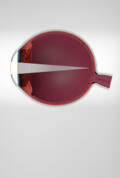
Myopia
Nearsightedness
A condition where distant objects
appear blurred while objects close
to you are sharp and clear.

Myopia
Nearsightedness
A condition where distant objects
appear blurred while objects close
to you are sharp and clear.

Myopia
Nearsightedness
A condition where distant objects
appear blurred while objects close
to you are sharp and clear.
What Is Myopia?
Myopia, or Nearsightedness, is a common vision condition where distant objects appear blurry while close-up vision remains clear.
This happens when light entering the eye focuses in front of the retina instead of directly on it. As a result, far-away scenes or objects may seem out of focus, making tasks like reading road signs or seeing a whiteboard difficult. Traditionally myopia can often be managed effectively with glasses or contact lenses. Today, modern advanced Ziemer laser treatments tailored to your needs could be an alternative life improvement option.
Myopia Solutions
As the Swiss leader in low energy femtosecond laser technologies, Ziemer's CLEAR Supra and LASIK Supra procedures have been developed to help correct myopia.
Ziemer's procedures utilize advanced laser technologies that are minimally invasive, quick and provide positive visual outcomes.
Treatment Options


CLEAR Supra is a minimally invasive, flapless laser procedure that can correct Myopia (Nearsightedness) with or without astigmatism. It is considered one of the most advanced laser eye surgery procedures.


LASIK Supra surgery is well-established and considered among the most successful procedures for laser vision corrections to treat Myopia (Nearsightedness), Hyperopia (Farsightedness) and astigmatism.
What are the symptoms of Myopia?

- Blurry Vision at a Distance: The primary symptom is difficulty seeing distant objects clearly. For example, road signs or classroom whiteboards may appear fuzzy.
- Squinting: To see more clearly, individuals often squint or partially close their eyelids.
- Headaches: Frequent squinting and straining to see distant objects can lead to headaches.
- Eyestrain: Prolonged effort to focus on distant objects can cause discomfort and fatigue in the eyes.
- Difficulty with Night Vision: Some people experience more pronounced blurry vision in low-light conditions, a condition known as night myopia.
- Sitting Close to Screens: Children with myopia might sit very close to the television or hold books and devices close to their face.
- Poor Performance in School: Difficulty seeing the board or screen can affect academic performance.
What causes myopia?

- Eye Shape: Myopia occurs when the eyeball is too long or the cornea is too curved. This causes light entering the eye to focus in front of the retina instead of directly on it, making distant objects appear blurry.
- Genetics: A family history of myopia increases the likelihood of developing the condition. If one or both parents are nearsighted, their children are at a higher risk.
- Close-Up Work: Spending a lot of time on activities that require focusing up close, such as reading, using computers, or smartphones, can contribute to the development of myopia.
- Lack of Outdoor Time: Some studies suggest that not spending enough time outdoors during childhood may increase the risk of developing myopia.
What is the ideal age for myopia corrective eye surgery?

The ideal age range for laser eye surgery, such as CLEAR Supra or LASIK Supra, to correct myopia is generally between 25 and 40 years old.
- Stable Vision: By the age of 25, most people's vision has stabilized, meaning their prescription hasn't changed significantly for at least a year. This stability is crucial for the success of the surgery.
- Age-Related Changes: Before the age of 25, vision can still be changing, and after 40, age-related conditions like presbyopia (difficulty seeing close objects) can start to develop.
However, the minimum age for corrective eye surgery is typically 18 years old, provided the individual's prescription has been stable.
It's always best to consult with an eye doctor to determine the most suitable time for the procedure based on personal eye health and vision stability.
What procedure is right for me?

Your doctor will do a full diagnostic analysis of your eye prior to recommending any eye procedures. Doctors have a range of values they must consider to fully understand the unique nature of your eye prior to recommending CLEAR Supra or LASIK Supra. Sometimes patients are candidates for both CLEAR Supra and LASIK Supra. CLEAR Supra is often a choice for individuals with active lifestyles that include running, action sports or combat sports as there is no flap created with CLEAR Supra.
CLEAR Supra produces great visual accuity, however vision continually improves over days and weeks where as LASIK Supra could have faster next day results. For those with less active lifestyles who require faster visual improvement for work then a doctor might recommend LASIK Supra over CLEAR Supra. Ultimately your doctor will be your source of guidance to the treatment that is right for you.






